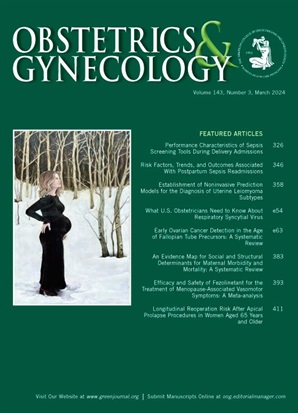妊娠期高血压疾病的产后利尿剂:系统回顾和荟萃分析。
IF 4.7
2区 医学
Q1 OBSTETRICS & GYNECOLOGY
引用次数: 0
摘要
目的系统回顾利尿剂在妊娠高血压疾病患者中降低产后高血压的应用情况。数据来源检索截止到2024年6月的medline、EMBASE、CINAHL和Cochrane中央对照试验登记册(PROSPERO CRD42021288277)。研究方法:纳入调查妊娠期高血压疾病患者产后利尿剂使用情况的随机对照试验,每组20人或以上。主要结局是产后2周内的高血压和治疗后的平均收缩压或舒张压。产后二次结局包括严重的产妇发病率、使用额外的抗高血压药物、再入院、产后6周高血压和母乳喂养。采用Cochrane手册评估偏倚风险。随机效应荟萃分析模型使用限制最大似然估计治疗效果,具有相对风险(RR)/平均差异和95% ci。表列、整合和结果在回顾的469份记录中,纳入了10项随机对照试验(1,815名个体:906名干预,909名对照)。干预措施包括呋塞米(5项试验,N=958)、托尔塞米(1项试验,N=118)、呋塞米联合降压药(3项试验,N=670)、噻嗪类药物联合血管紧张素转换酶抑制剂(1项试验,N=67)。7项试验存在高偏倚风险。利尿剂的使用与产后2周内高血压的降低相关(5项试验,N=1,055,合并RR 0.54, 95% CI, 0.39-0.74;治疗所需数量[NNT] 4)。使用利尿剂治疗后,两组患者的平均收缩压和舒张压无差异;在严重的产妇发病率、再入院率或任何其他次要结局方面也没有差异。当分析仅限于低偏倚风险的试验时,产后高血压的减少并不显著(两项试验,N=502, RR 0.62, 95% CI, 0.36-1.09)。结论:利尿剂与妊娠高血压疾病(NNT 4)患者产后立即高血压的降低相关,尽管在低偏倚风险的试验中没有观察到这种降低。需要进一步的研究来评估利尿剂在治疗产后高血压中的作用。系统评审注册号:prospero, crd42021288277。本文章由计算机程序翻译,如有差异,请以英文原文为准。
Postpartum Diuretics for Hypertensive Disorders of Pregnancy: A Systematic Review and Meta-analysis.
OBJECTIVE
To systematically review the use of diuretics to reduce postpartum hypertension among individuals with hypertensive disorders of pregnancy.
DATA SOURCES
MEDLINE, EMBASE, CINAHL, and Cochrane Central Register of Controlled Trials were searched through June 2024 (PROSPERO CRD42021288277).
METHODS OF STUDY SELECTION
Randomized controlled trials investigating postpartum diuretic use in individuals with hypertensive disorders of pregnancy with 20 or more participants per arm were included. Primary outcomes were hypertension within 2 weeks postpartum and mean systolic or diastolic blood pressure after treatment. Secondary postpartum outcomes included severe maternal morbidity, use of additional antihypertensives, readmission, hypertension at 6 weeks postpartum, and breastfeeding. Risk of bias was assessed with the Cochrane handbook. A random-effects meta-analysis model used the restricted maximum-likelihood estimated treatment effects with relative risk (RR)/mean difference and 95% CIs.
TABULATION, INTEGRATION, AND RESULTS
Of 469 records reviewed, 10 randomized controlled trials were included (1,815 individuals: 906 intervention, 909 control). Interventions included furosemide (five trials, N=958), torsemide (one trial, N=118), combined furosemide-antihypertensive drug (three trials, N=670), and combined thiazide-angiotensin-converting enzyme inhibitor (one trial, N=67). Seven trials were at high risk of bias. Diuretic use was associated with a reduction in hypertension within 2 weeks postpartum (five trials, N=1,055, pooled RR 0.54, 95% CI, 0.39-0.74; number needed to treat [NNT] 4). There was no difference in mean systolic or diastolic blood pressure after treatment with diuretics; there was also no difference in severe maternal morbidity, readmissions, or any other secondary outcomes. When analysis was restricted to trials at low risk of bias, the reduction in postpartum hypertension was not significant (two trials, N=502, RR 0.62, 95% CI, 0.36-1.09).
CONCLUSION
Diuretics were associated with a reduction in immediate postpartum hypertension in individuals with hypertensive disorders of pregnancy (NNT 4), although this reduction was not observed when analysis was restricted to trials at low risk of bias. Further studies are needed to assess the role of diuretics in treating postpartum hypertension.
SYSTEMATIC REVIEW REGISTRATION
PROSPERO, CRD42021288277.
求助全文
通过发布文献求助,成功后即可免费获取论文全文。
去求助
来源期刊

Obstetrics and gynecology
医学-妇产科学
CiteScore
11.10
自引率
4.20%
发文量
867
审稿时长
1 months
期刊介绍:
"Obstetrics & Gynecology," affectionately known as "The Green Journal," is the official publication of the American College of Obstetricians and Gynecologists (ACOG). Since its inception in 1953, the journal has been dedicated to advancing the clinical practice of obstetrics and gynecology, as well as related fields. The journal's mission is to promote excellence in these areas by publishing a diverse range of articles that cover translational and clinical topics.
"Obstetrics & Gynecology" provides a platform for the dissemination of evidence-based research, clinical guidelines, and expert opinions that are essential for the continuous improvement of women's health care. The journal's content is designed to inform and educate obstetricians, gynecologists, and other healthcare professionals, ensuring that they stay abreast of the latest developments and best practices in their field.
 求助内容:
求助内容: 应助结果提醒方式:
应助结果提醒方式:


